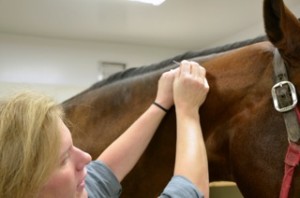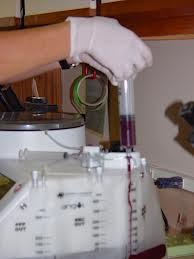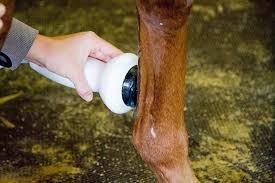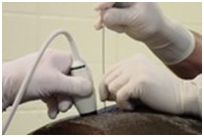Sports Medicine
The horse is naturally, by right of birth and genetics, an elite athlete. Pound for pound, the horse is able to run faster and longer than any of the other domesticated species, including humans! In addition to speed and endurance, the horse has the gift of natural athletic grace – the Lippizaner’s airs above the ground are foreshadowed by the balletic leaps of the foal at pasture with its mare, and the patterns inscribed by a good reining horse can be seen in the quick turns and spins of yearlings out at pasture. To our great delight, horses seem to be naturally amenable to working with humans, and the best of them have not only a competitive nature, but a desire to please. Altogether, their speed, endurance, grace, trainability, and competitive nature allow us to enjoy the beauty and excitement of a large variety of competitive and recreational equine sports.
Exams
Equine Soundness Exam
 Chicago Equine believes in evaluating the whole horse with a comprehensive and integrative approach. A soundness exam is like solving a puzzle, and requires a methodical and consistent approach. After discussing your concerns about the horse, our vets will begin with a visual inspection of the horse, looking for swelling, atrophy, abnormal hoof wear, or conformational problems. A physical exam is often performed by our vets which includes palpation of joints, tendons, ligaments and muscles. The horse is walked and jogged (often under saddle) looking for lameness. A hoof tester is applied to the feet prior to a dynamic flexion or stress test. Each limb is flexed for a period of time to try and intensify low grade lameness.
Chicago Equine believes in evaluating the whole horse with a comprehensive and integrative approach. A soundness exam is like solving a puzzle, and requires a methodical and consistent approach. After discussing your concerns about the horse, our vets will begin with a visual inspection of the horse, looking for swelling, atrophy, abnormal hoof wear, or conformational problems. A physical exam is often performed by our vets which includes palpation of joints, tendons, ligaments and muscles. The horse is walked and jogged (often under saddle) looking for lameness. A hoof tester is applied to the feet prior to a dynamic flexion or stress test. Each limb is flexed for a period of time to try and intensify low grade lameness.
Once a lame limb is identified, we are only part way through the puzzle. Diagnostic blocks are performed in a set pattern. Detailed knowledge of the horse’s anatomy is necessary to block the nerves and joints successfully. After each block the horse is again jogged or flexed to evaluate the impact on the lameness. Once the lameness is resolved, we have localized the lameness to a specific area of the limb.
To complete the exam and completely solve the puzzle, diagnostic imaging is necessary. Depending on the location of the lameness, we may recommend taking radiographs and/or ultrasound the area. Digital radiographs allow our vets to see fine details of the boney structures. Our ultrasounds are some of the most advanced available and allow us to look at bone, cartilage, muscle, tendons, and ligaments. Occasionally we cannot identify the source of the pain after radiographs and an ultrasound. If the lameness is localized to a specific area then a MRI or CT scan may be recommended. If it is a joint that can’t be imaged with MRI or CT then arthroscopic surgery may be recommended. In those cases where the horse has multiple lamenesses or we are unable to pin point the lameness then Nuclear Scintigraphy(Bone Scan) is recommended. Once the area of the limb is identified and we are able to find the source of the problem, our vets will discuss the different treatment options for your horse.
Pre-Purchase Examination
The objective is to perform a risk assessment examination for the buyer in relation to the general health and athletic soundness of the horse for sale. The examination will help to ascertain any pre-existing problem or any potential problem that may affect future ability of the horse to excel in the desired discipline. The exam addresses concerns seen at that specific moment in time. This examination covers an extensive physical that assesses numerous body systems with additional focus on the musculoskeletal & neuromuscular system, flexion tests, movement evaluation on different surfaces and preferably under saddle for a ridden evaluation. Additional diagnostic procedures including radiography, ultrasonography, upper airway endoscopy, nuclear scintigraphy and MRI are available at the buyer’s option. Drug testing, complete blood count, blood chemistry and other laboratory work as needed/requested.
Neurological Exam
The neurological evaluation involves watching the horse walk forward and backward. Then raise the head to take away the ground surface and repeat walking forward and backwards. The horse should be walked in as small of a circle as they can, as long as they are moving forward, to see if they swing either the front or back outside leg wide, drag the toe or snap the inside leg up quickly. Next, the horse should be blindfolded and walked forward, this tests the horse’s balance. If he gets ataxic (drunk, sways or gets pacey gaited), there is a problem. The proprioception for legs (which is the horse knowing where their legs are supposed to be) should be tested by crossing the front legs over one another in both directions to see if they move them back in place. Next, the hind legs should be crossed behind one another in both directions. One must be careful in interpretation of this test because some horse’s just want to please so they will leave their legs where ever you place them. Another way to test proprioception is to place the legs as far away from the body as possible and see if they will pull them back into the correct place.
Included in the neurological evaluation would be testing the cranial nerves as well as tail tone. Then lastly the horse should be walked in a straight line while one is pulling the tail to the side. This should be done from both sides to see if one side is weaker than the other. If possible, one should watch the horse walk up and down an incline with the head in normal position and then with the head elevated.
Click here for more information on neurologic diseases
Acupuncture Exam
 Generally an acupuncture exam and treatment will last from 45 to 90 minutes. Initially a detailed history of the horse is taken, including information on their personality, current problem, past problems, and medications.
Generally an acupuncture exam and treatment will last from 45 to 90 minutes. Initially a detailed history of the horse is taken, including information on their personality, current problem, past problems, and medications.
An exam is then performed including palpation of the jugular pulse, evaluation of the tongue and scanning the body for point sensitivity. After this, a plan is made and needles are placed. Most horses tolerate needles well, many even seem to become somewhat sedated or fall asleep as treatment proceeds. Besides placement of dry needles, most treatments include electro-acupuncture which involves attaching leads to the needles and passing a small electrical current between them. Electrical stimulation is kept to a low level that seems to relax most horses, however, occasionally a “blockage” is suddenly removed causing horses to react by kicking out or startling. Click here for more info.
The exams listed above are just a few of the exams offered by Chicago Equine.
Treatments
Regenerative Medicine
What is regenerative medicine? After an injury, each organ or tissue type in the body has a specific capacity to heal or scar afterwards. Some organs or tissue types can accomplish this healing without assistance, while other areas benefit from additional therapies to complete the healing process. The techniques that help this healing process are called “regenerative medicine.” These techniques make use of the body’s own stem cells (progenitor cells), which are cells that are present and capable of making new normal tissue, but typically do not do so without medical intervention.
***The harvest, processing and injection of stem cells can now be done in one outpatient visit to us at the hospital. Our new PRP machine has the capability of being used to harvest bone marrow derived stem cells for wound healing and soft tissue injuries***
Platelet-Rich Plasma
 Platelets in blood contain growth factors that stimulate cells in injured tissue to begin healing and draw new cells into the injured area. Blood is drawn from the patient and centrifuged to separate the white and red blood cells for removal and to concentrate the platelets in the plasma to five times that of whole blood. The gel is then injected at the site of the injury. Injection of PRP is recommended for both recent tendon and ligament injuries and those injuries that have not healed using traditional rest and controlled exercise. Plasma containing this concentrated level of platelets provides an abundance of growth factors, which are the proteins in the body that stimulate cells in the tendon or ligament to start the healing process. When PRP is injected into damaged tendon or ligament, cells in the tissue along with new cells circulating in the blood are stimulated to reproduce new cells at the site of injury. These healing cells work to increase the formation of new blood vessels and connective tissue, all of which encourages natural repair of the injury. Ligaments, in particular, can degenerate over time and, in some cases, the normal healing and remodeling process does not reach an adequate level. PRP is used to help initiate cell response, so that the normal healing process is stimulated and can proceed. As such, a PRP treatment can be particularly helpful in cases where the healing process has stalled. This treatment helps assure that the injury is completely healed and that the risk of re-injury is lessened. PRP can be used as a stand-alone treatment or in conjunction with other therapies, including stem cell treatments and surgery.
Platelets in blood contain growth factors that stimulate cells in injured tissue to begin healing and draw new cells into the injured area. Blood is drawn from the patient and centrifuged to separate the white and red blood cells for removal and to concentrate the platelets in the plasma to five times that of whole blood. The gel is then injected at the site of the injury. Injection of PRP is recommended for both recent tendon and ligament injuries and those injuries that have not healed using traditional rest and controlled exercise. Plasma containing this concentrated level of platelets provides an abundance of growth factors, which are the proteins in the body that stimulate cells in the tendon or ligament to start the healing process. When PRP is injected into damaged tendon or ligament, cells in the tissue along with new cells circulating in the blood are stimulated to reproduce new cells at the site of injury. These healing cells work to increase the formation of new blood vessels and connective tissue, all of which encourages natural repair of the injury. Ligaments, in particular, can degenerate over time and, in some cases, the normal healing and remodeling process does not reach an adequate level. PRP is used to help initiate cell response, so that the normal healing process is stimulated and can proceed. As such, a PRP treatment can be particularly helpful in cases where the healing process has stalled. This treatment helps assure that the injury is completely healed and that the risk of re-injury is lessened. PRP can be used as a stand-alone treatment or in conjunction with other therapies, including stem cell treatments and surgery.
IRAP
 Interleukin-1 receptor antagonist protein utilizes about 50 milliliters of the horse’s own blood, drawn into a syringe containing special glass beads, and incubated for 24 hours. Then the blood is centrifuged to separate out the red blood cells. The result is an enriched serum, which contains anti-inflammatory proteins that block the harmful effects of interleukin-1, an inflammatory mediator that accelerates the destruction of cartilage (when cartilage is destroyed, lameness results). The enriched serum is administered into the horse’s affected joint once a week for 3-5 treatments. Studies so far have shown significant decreases in lameness. Chicago Equine was one of the first to use this therapy and it is one of the best treatment regimes for degenerative joint disease in the horse.
Interleukin-1 receptor antagonist protein utilizes about 50 milliliters of the horse’s own blood, drawn into a syringe containing special glass beads, and incubated for 24 hours. Then the blood is centrifuged to separate out the red blood cells. The result is an enriched serum, which contains anti-inflammatory proteins that block the harmful effects of interleukin-1, an inflammatory mediator that accelerates the destruction of cartilage (when cartilage is destroyed, lameness results). The enriched serum is administered into the horse’s affected joint once a week for 3-5 treatments. Studies so far have shown significant decreases in lameness. Chicago Equine was one of the first to use this therapy and it is one of the best treatment regimes for degenerative joint disease in the horse.
Stem Cell Therapy
Stem cell treatments can be used for a number of lameness problems, including bone cysts, joint problems, and tendon injury. Stem cells are the cells in the body that are capable of re-forming tissues and can be isolated from a reliable source, such as bone marrow or adipose (fat) tissue. The cells are grown and multiplied until  adequate numbers are available to treat the injury by injecting them into the lesion. The stem cells contribute to healing in several ways: they can themselves help build new tissue, they recruit cells to contribute to healing, and they have an anti-inflammatory effect on the tissue. Areas where stem cells are most needed include tendon injury, more severe ligament injuries, meniscal injury, and joint damage. Stem Cell can be used for degenerative joint disease (osteoarthritis), fractures, tendon, suspensory, and ligament injuries, osteochondrosis (OCD) and sub-chondral bone cysts. The process involves a simple fat collection, followed two days later by an injection of the recovered stem cells into the injury site. Recovery generally consists of a few weeks of stall rest with hand walking.
adequate numbers are available to treat the injury by injecting them into the lesion. The stem cells contribute to healing in several ways: they can themselves help build new tissue, they recruit cells to contribute to healing, and they have an anti-inflammatory effect on the tissue. Areas where stem cells are most needed include tendon injury, more severe ligament injuries, meniscal injury, and joint damage. Stem Cell can be used for degenerative joint disease (osteoarthritis), fractures, tendon, suspensory, and ligament injuries, osteochondrosis (OCD) and sub-chondral bone cysts. The process involves a simple fat collection, followed two days later by an injection of the recovered stem cells into the injury site. Recovery generally consists of a few weeks of stall rest with hand walking.
Autologous Bone Marrow
Bone marrow, which contains stem cells, fibrin, granulocytes, monocytes, neutrophils, and growth factors, is aspirated from the patient’s sternum or the point of its hip and immediately injected into the site of the injury. Fewer stem cells are present in bone marrow (0.01% than in fat tissue (43%), but the growth factors and other nutrient cells present in bone marrow may work together to enhance healing. Recent technology has enabled bone-marrow aspirate to be significantly concentrated before it is injected into damaged tissue.
Shockwave Therapy
 Shockwave therapy is used for tendon and ligament injuries and to stimulate bone remodeling. Focused high frequency shockwave therapy consists of a single acoustic pulse of extremely short rise time and a very high pressure maximum, which expends enormous amounts of acoustic energy focused on a small area. The surrounding tissue is treated as gently as possible. Shockwave therapy increases new bone formation and cuts down on healing time. It is a non-invasive procedure with an average treatment time of 30 minutes.
Shockwave therapy is used for tendon and ligament injuries and to stimulate bone remodeling. Focused high frequency shockwave therapy consists of a single acoustic pulse of extremely short rise time and a very high pressure maximum, which expends enormous amounts of acoustic energy focused on a small area. The surrounding tissue is treated as gently as possible. Shockwave therapy increases new bone formation and cuts down on healing time. It is a non-invasive procedure with an average treatment time of 30 minutes.
The indications for use include, but are not limited to:
- Tendonopathies with or without calcification
- Calcification of the nuchal ligaments
- Splint bone fractures
- Sesamoiditis
- Sacroiliac disease
- Sore Back
- Insertion desmopathies
- Anthropathies
- Deforming arthritis of the limb joints
- Navicular disease
- Stricture of the annular ligament
- Exostosis
Mesotherapy
Mesotherapy is a treatment that stimulates the mesoderm, the middle layer of the skin, which will, in turn relieve a wide variety of symptoms and ailments. The technique involves the injection of substances to stimulate the mesoderm for various biological purposes.  The mesotherapy injections involve extremely small needles that penetrate the interdermal layer of the skin only a very small depth, which is typically four to six millimeters.
The mesotherapy injections involve extremely small needles that penetrate the interdermal layer of the skin only a very small depth, which is typically four to six millimeters.
The number of treatments needed depends on many variables including the condition, the abnormal physiology causing the condition, as well as the chronicity of the problem. A minimum of one to two sessions of mesotherapy are performed to assess the horse’s response. Mesotherapy is effective for a multitude of conditions because it helps reverse the physiology of that condition, and stop the pain spasm cycle.
Ultrasound Guided Injection Treatment (USGI)
 This is a technique to more precisely deliver treatment to the appropriate region. This is particularly important for areas of the neck, back hip and sacroiliac area. USGI utilized high quality ultrasound to visualize the anatomical structure to be treated. Needles are placed along the plane of the ultrasound beam to allow visualization and then medication can be administered. This optimizes precision of therapy and can be used for tendon, ligament, joint and bone injuries.
This is a technique to more precisely deliver treatment to the appropriate region. This is particularly important for areas of the neck, back hip and sacroiliac area. USGI utilized high quality ultrasound to visualize the anatomical structure to be treated. Needles are placed along the plane of the ultrasound beam to allow visualization and then medication can be administered. This optimizes precision of therapy and can be used for tendon, ligament, joint and bone injuries.














